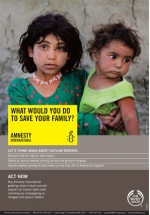For the module ‘Design Thinking’ our project is to create a visual response to a contemporary issue facing Australian society. With the two main contemporary
issues highlighted being:
1. Australia’s approach to asylum seekers arriving by boat
2. Australia’s approach to climate change / global warming
3. Choose your own topic (to be approved by staff)
Using Ambrose and Harris’ (2010) 7 stage design process model to design a poster on one of the key contemporary issues listed above we are to gain an understand of historical perspectives and represent multiple viewpoints. We are then instructed to research at least 3 different visual approaches to employ in our creative response. Using this model as a key to discover and define the specific issue and the way we wish to visually approach it. We must consider different viewpoints to avoid bias and maybe even influence our own perspective on a specific issue. Although to accompany the poster we are encouraged to keep a reflective journal. This journal will be used to write the report, the aim of this is to allow us to reflect on the creative design project in the ways of: reflecting on the design process and the outcomes of it, to identify and analyse significant incidents, to experience, identify and discuss.
Researching the above issues I decided to look at the way other companies and designers have portrayed these issues.
Beside are two interesting approaches I found towards climate change: The poster on the left represents rates of formation and consumption and the threatening of both of these as a whole. And the poster on the right represents the way changing conditions affect all living things and the way we rely on one another to sustain life.
Beside are two interesting approaches I found towards asylum seekers: The poster on the left is the body shop campaign promoting awareness and educating customers, encouraging everyone to think about asylum seeks. And the poster on the right represents the governments message to asylum seekers creating the message that they will not be settle here.




